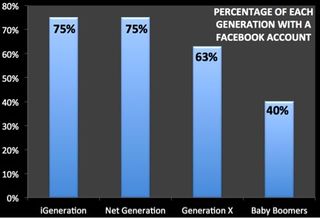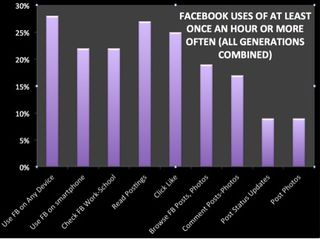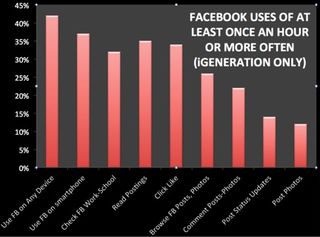Media
Our Social Media Obsession
What is driving people to constantly check in with social media?
Posted July 18, 2014 Reviewed by Davia Sills
As part of my continuing process of examining the impact of technology, my colleagues and I at the George Marsh Applied Cognition Lab have recently completed a large study looking at a variety of technology and media uses across members of four generations: Baby Boomers (born between 1946 and 1964), Generation X (1965-1979), Net Generation (1980-1989), and iGeneration (1990-1999).
In the current study, we administered a variety of survey instruments to 1,038 members of these generations to determine what technologies people were actually using, how they were navigating their commitment to social media, and finally, what factors might predict who would use more or less technology. This post will deal with the question of social media use. Future posts will cover more general technology use, as well as what might predict more or less use of various technologies.
As part of this study, participants were asked whether they had a social media presence on eight sites, including Facebook, MySpace, Twitter, LinkedIn, Tumblr, Pinterest, Flickr, and Instagram. A final question asked participants to list additional sites that they used, but none were used by more than a handful of people other than the eight listed sites.
Let’s start with Facebook since it is the most common social media site. Overall, across all generations, 70 percent of participants had a Facebook account, which parallels the worldwide statistics. The chart below with the blue bars shows the percentage of participants who reported having a social media presence on Facebook.

Although younger generations are more prominently featured as Facebook users, even 40 percent of Baby Boomers have a Facebook account.
Looking at only those participants who used at least one social media site, overall younger generations used more social media sites than older ones, but the average for younger generations was only around two compared to one site for older generations.
As I said previously, the most popular site was Facebook. Across all generations, in order, the following percentage of participants used a variety of social media sites: Instagram (27 percent), Twitter (26 percent), MySpace (18 percent), Pinterest (17 percent), Tumblr (12 percent), LinkedIn (11 percent), and Flickr (5 percent). All showed the same generational trends as Facebook, except LinkedIn and Flickr, which showed no difference across generations.
The figure below with the multi-colored lines shows the generational similarities and differences in social media usage across generations. Other than LinkedIn and Flickr at the far right, the other social media sites showed similar patterns, with younger generations more likely to have social media accounts than older generations.

In fact, just as with Facebook, there appears to be a clear generational difference, with iGeneration and Net Generation young adults being the avid social media users, while Gen Xers and Baby Boomers are less likely to use all social media sites.
Facebook Use
The measurement tool also queried specific uses of Facebook, which sheds light on exactly what activities people are doing on the most popular social media site.
The first chart below with light purple bars shows the data for all participants in any generation, and the one below that with the pink bars shows the same results for the iGeneration teens and young adults only. The bars show the percentage of people who are using Facebook or various Facebook activities at least once an hour or more often.

It is obvious that whether you look at every participant or just the iGeneration, older teens and young adults' Facebook is being used often on a smartphone and also at work or at school.
In addition, the most common activities are reading postings, followed by clicking “Like” (see my earlier post entitled The Power of "Like") and browsing posts and photos with fewer people commenting and posting their own updates or photos.
Below is the chart with the pink bars for the iGeneration older teens and young adults where more than one in three iGeneration older teens and young adults are doing the main five Facebook activities—using it on any device, using it on a smartphone, checking it at work or school, reading postings, and clicking “Like”—at least once an hour.

Facebook users were also asked about their online friendships, including their total number of Facebook friends, the number of Facebook friends they also know in person, the number of people they had met online and never met in person, and the number of people that they regularly interact with online and have never met in person on a nine-point scale ranging from “never” to 751 or more.
The table below shows the results across generations. As you can see, there is a steady increase in Facebook friends from between 51 and 100 for Baby Boomers to 251-375 for iGeners, and the same trend is evident from those that they know in person, although it is clear that all generations know more than four in five of their Facebook friends, ranging from 82 percent of the iGeneration to 87 percent of Gen X, 86 percent of Baby Boomers, and 85 percent of Net Geners.

In terms of people they know online but have not met in person, there were no generational differences, with an average of about 1-50 people with the mean closer to the lower end, and the same is true for people they regularly interact with online but do not know in person, which averages somewhat fewer people than those met online and have not met in person.
All in all, the people on Facebook know most of their “friends” and have very few friends that they interact with regularly online, but don’t know in the real world.
Predicting Social Media Use
In keeping with the theme of social media, participants were asked a series of questions about their level of anxiety if they are not allowed to check in with their technological world. For example, when asked, “If you can’t check in with text messages as often as you’d like, how anxious do you feel?” nearly half of iGeneration and Net Generation participants said they would feel moderately anxious to highly anxious.
With respect to social media, they were asked, “If you can’t check in with Facebook as often as you’d like how anxious do you feel?” and although the anxiety about missing out on social media is not as high as not checking text messages, one in four iGeneration participants and one in five Net Generation participants reported that they would feel moderately-to-highly anxious if they were not allowed to check in with Facebook as often as they like.
Finally, the study was designed to attempt to predict technology use, which, in this blog post, is social media use. In addition to the data reported, we also administered a measure of multitasking preference, an executive functioning measure, as well as assessing positive and negative attitudes toward technology in general, anxiety about not checking in with “new communication modalities” (e.g., texts, social media, and cellphone calls), anxiety about not being able to check in with “old communication media” (e-mail and voicemail), anxiety and dependence on technology in general, and the total number of social media sites at which they had an account.
Each of these was entered in a hierarchical regression equation, first factoring out all demographic variables, including age, median income, gender, ethnic background, etc., and then determining which of those measures best predicted a host of technology use variables. For this blog post, I want to point out a few of those:
- Social media usage (derived from our recently published Media, Technology Usage and Attitude Scale) was best predicted by only one variable: anxiety about not being able to check-in with new communication modalities as often as you’d like.
- The number of Facebook friends was best predicted by three variables (in order of contribution): total social media sites at which the participant had an account, negative attitudes toward technology (a negative predictor), and anxiety about not being able to check-in with new communication modalities as often as they would like.
The fact that anxiety plays such a huge role in the use of social media also was seen in predicting the use of other technologies, including a measure of total daily technology use. Anxiety about not be able to check-in was a significant predictor in all 12 regression analyses, followed by total social media sites (a predictor in 7 of the 12), positive attitudes (7 of the 12), and multitasking preference (5 of the 12).
What is Driving Us? Anxiety or Pleasure?
The bottom line is that we are finding ourselves using technology for a variety of reasons ranging from anxiety to pleasure (positive attitudes). What does it all mean? From our study alone, it appears that people are using their technology for a combination of gaining some pleasure and from avoiding anxiety about not knowing what is going on at every moment on every electronic communication platform, including social media.
If I had to estimate the contributions to our behavior, I would say that our data support about a 3:1 ratio of anxiety reduction to pleasure. We are still checking in all the time to gain a bit of pleasure (perhaps a squirt of dopamine or serotonin), but I think that what is driving our behavior of constantly checking in with our technology, regardless of whether we have received an alert or notification—an external interruption—or we are musing about missing out on something in our virtual social world—an internal interruption—is akin to an obsession or compulsion, both of which are anxiety-driven issues.
We have not sunk to the level of a psychiatric disorder, like obsessive-compulsive disorder, but we are not far away. Just watch people in the world around you. If you are watching a young person who is not looking at his or her phone, keep watching. Soon that phone will come out of the pocket or purse, most likely without having gotten an alert or notification, but being driven by a combination of pleasure and anxiety.
My question to you is how much do you feel you “check-in” with your virtual world due to wanting to feel good about what you will find there or making sure that you are not missing out on something important going on that you were privy to? From observation alone, I would guess that if you are, say, under 35 or 40, you are probably driven by anxiety more than pleasure, particularly when it comes to social media.
That makes sense to me because, in the last few years, we have gone from a world with only a few electronic communication modalities (e-mail, phone calls, text messages) to one in which our communications come from so many social media sites that we may not even be able to list them all.
My guilty pleasures are checking Facebook and Twitter, and they both provide me with little “reminders” to check-in. Right now, my Facebook tab shows that I have four alerts, messages, comments, or whatever, and my Twitter feed, scary as it sounds, tells me that I have 128 tweets among the dozen or so neuroscientists that I follow… nope, that just jumped to 129… and now 130.
Now I am really getting anxious. How will I ever keep up?




